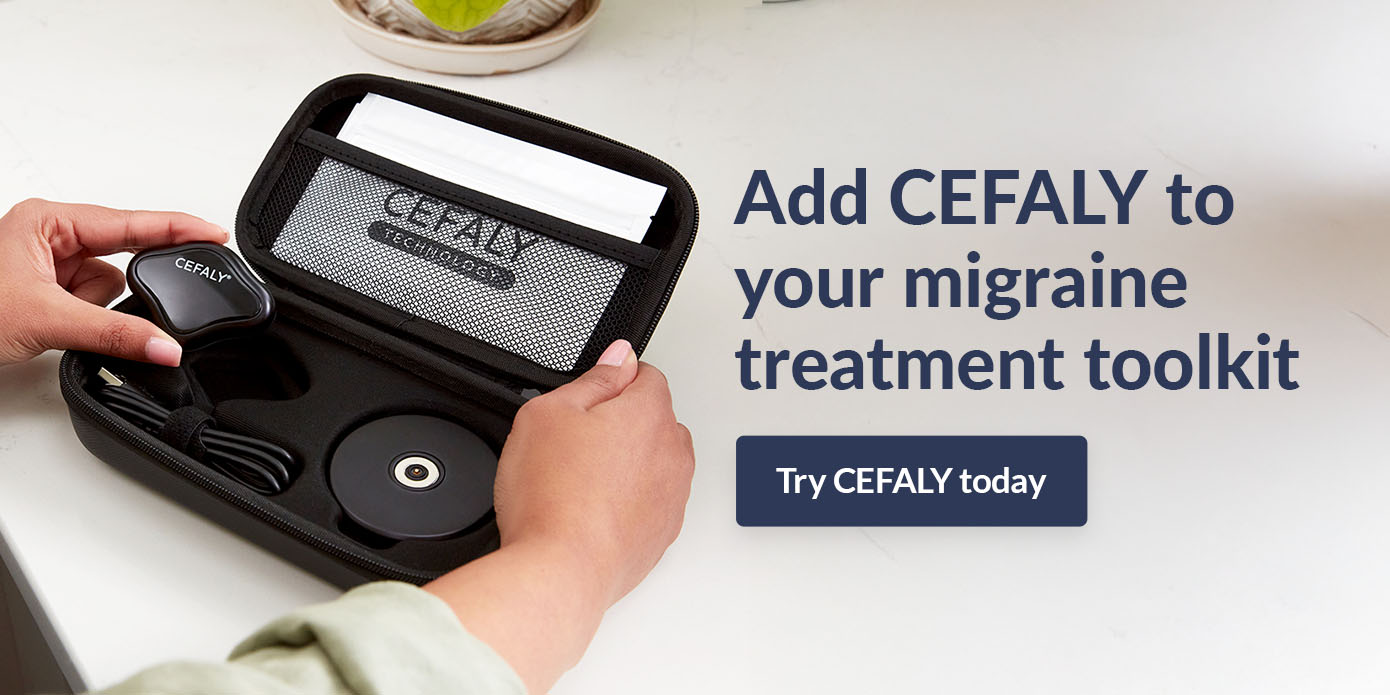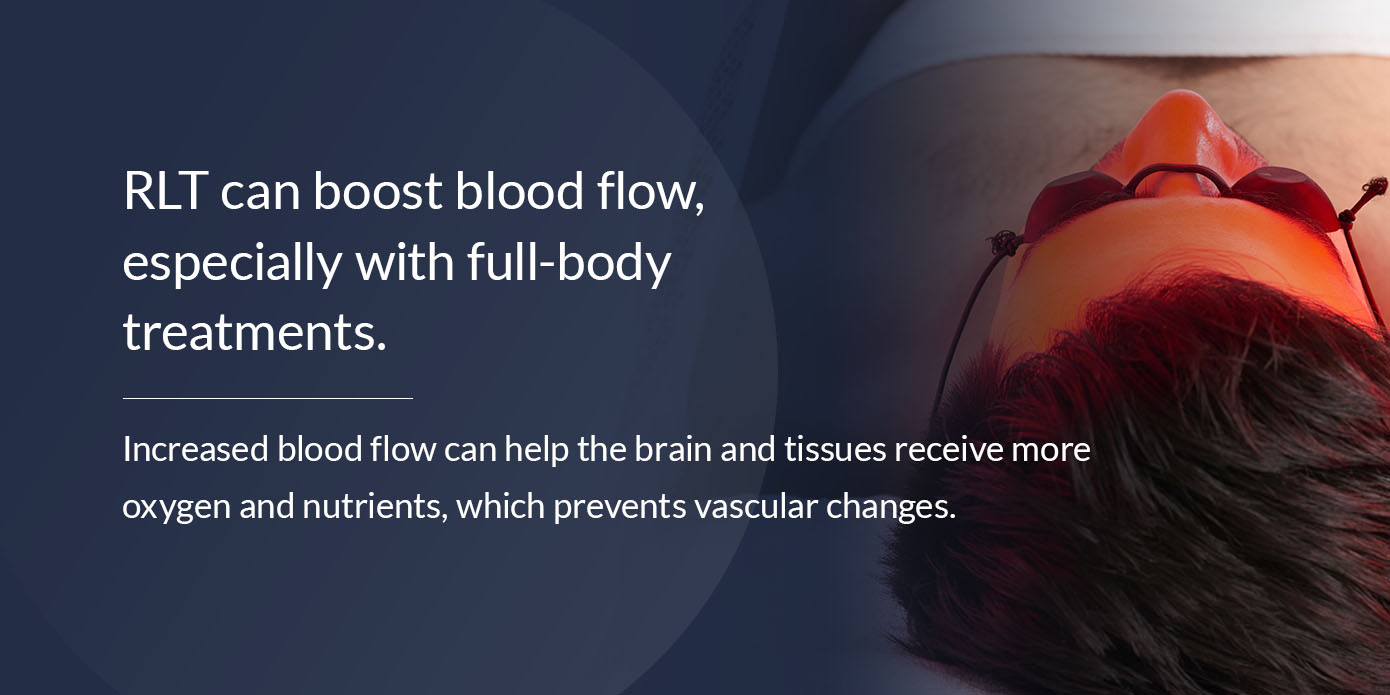Red light therapy (RLT) is said to help with glowing skin and luscious hair, but recently, there have been whispers of its supposed benefits for migraine disorder, too. Is it true that RLT can be beneficial for dealing with migraine symptoms? What does the research say?
Learn whether red light therapy is suitable for migraine and how the CEFALY device can provide acute relief and prevention.
What is red light therapy?
Red light therapy, also known as photobiomodulation, uses near-infrared light that’s emitted by low-energy lasers or LED lights. This red light triggers biological responses at a cellular level.
Most red light therapy devices for home use create low-level wavelengths that are commonly used to improve skin and aid hair growth. High-level wavelengths are used in professional settings. Here are some examples of how red light therapy is administered through various devices:
- Wall-mounted panels: These panels offer full-body treatment and can often deliver higher-intensity light output in shorter sessions. They are also used as a preventive measure, providing red light therapy for migraine to potentially prevent or lower the chances of attacks.
- Red light beds: These beds are easy to spot because they resemble tanning beds. They’re commonly used for circulation support and muscle recovery.
- Wands: These handheld devices provide portable treatments, often used for skincare. Some wands may be used for migraine treatments.
- Masks: These masks typically use a combination of red light and near-infrared therapy to target specific skin conditions like fine lines. They can also treat migraine, but they may miss some of the problem areas at the back of the head.
- Caps and helmets: These caps are typically designed specifically for hair growth and scalp treatments. Some of them may be useful for treating migraine and they offer full coverage of the head. However, they can be bulky and difficult to carry around.
How could RLT help with migraine?
Although red light therapy is typically used for skincare or hair growth applications, some believe it could also help with migraine. Here are some of the potential benefits of red light therapy for migraine:
Enhanced anti-inflammatory effects
Research shows that RLT may modulate cytokine production, leading to a decreased production of the cytokines that cause increased inflammation. By reducing these pro-inflammatory cytokines, RLT simultaneously boosts the levels of anti-inflammatory cytokines. Its ability to lower inflammation may target one of the key causes of migraine attacks.
Improved resilience and reduced severity
Red light therapy works through a process called photobiomodulation. In this process, red and near-infrared light photons penetrate the skin and go all the way to the mitochondria. RLT boosts the production of adenosine triphosphate (ATP), which is the energy that feeds the cells.
This boost in cellular metabolism might improve resilience against migraine triggers. It may also reduce the frequency of migraine episodes when used consistently.
Increased vasodilation
Poor blood flow and the sudden constriction of blood vessels, also known as vasospasm, is one of the most common triggers of migraine. RLT can boost blood flow, especially with full-body treatments. Increased blood flow can help the brain and tissues receive more oxygen and nutrients, which prevents vascular changes.
A glimpse into the research: What does the science say?
Research on red light therapy for migraine is still in the early stages. Studies so far have shown promise in phototherapy, having anti-inflammatory properties that may be beneficial in treating various conditions like seasonal affective disorder (SAD), arthritis and skin conditions.
When it comes to migraine, the main way that RLT might help is with cytokine manipulation. One recent study found that when the skin is exposed to phototherapy, the level of cytokines that fight pain increases. It has the potential to reduce inflammation, which might lower the severity of the migraine attack and change the perception of the severity of the pain.
Studies on red light therapy have mixed reports. Sometimes, red light therapy can trigger headaches in certain light-sensitive individuals or may have no effect at all. Newer research is leaning toward green light therapy, which boosts pain relief chemicals in the brain and doesn’t cause the pain that other colors of light therapy may sometimes bring.
There are other medical devices that also show clinically proven benefits for migraine. CEFALY is an excellent example of a noninvasive, drug-free option for migraine pain relief. It’s a clinically proven, FDA-cleared medical device that can be used to prevent attacks. It also offers in-the-moment pain relief. One major clinical study found that 79% of participants with acute migraine experienced pain relief following one hour of treatment with CEFALY.
Get Drug-Free Migraine Relief With CEFALY
Shop Now
90-day money back guarantee
FDA-cleared
financing available
How is RLT used for migraine?
There are several ways to use RLT, depending on the severity of the condition, the setting and the type of device. There are four stages of migraine:
- Prodrome
- Aura, which is only experienced by some
- Migraine attack
- Postdrome
RLT produces the best results when used in the prodrome or aura phase. It can also be used during an attack, but depending on the severity, the relief may be delayed.
Clinical RLT treatments typically involve healthcare professionals setting up the machine and timing the session. At-home devices are a bit more complex. Here’s how to use red light therapy for migraine:
- When you feel the migraine coming on, start with shorter sessions. As you get used to them, you can increase the frequency and duration of the sessions.
- If you’re using a handheld device, focus on your head and neck, keeping it on areas that are concentrated with pain before moving to other spots.
- Work with a healthcare provider to determine the ideal duration for your migraine. If you don’t find relief, you may need to look into another treatment option.
RLT vs. CEFALY: What are the differences?
Both CEFALY and red light therapy can help headaches caused by migraine, but they work through different mechanisms. RLT uses wavelengths of light to reduce the inflammation associated with migraine, whereas CEFALY is a neuromodulation device that directly targets the trigeminal nerve, which is the primary pathway associated with headache pain. Here’s a comparison table to make your decision easier:
| CEFALY | Red Light Therapy (RLT) |
| CEFALY uses neuromodulation to send a mild electrical current to the main nerve involved in migraine pain. | RLT uses light wavelengths to penetrate the skin and manipulate cytokines, reducing inflammation. |
| There have been major studies on CEFALY, showing a majority of participants experiencing pain relief. | Some studies have shown promise for RLT in treating pain, but there hasn’t been major studies showing a positive majority effect for migraine. |
| CEFALY is clinically proven and FDA cleared for migraine relief and prevention. | RLT is still lacking on studies for migraine treatment and while many devices are FDA cleared, these devices aren’t cleared specifically for migraine. |
| You can use CEFALY for preventative and immediate care without help from medical professionals. | Some RLT may require assistance from medical professionals or the use of professional equipment like RLT beds. |
| CEFALY has not been shown or reported to cause migraine, but it may not be suitable for individuals with cutaneous hypersensitivity or those with a cardiac pacemaker. | Red light therapy can sometimes cause migraine due to the intensity of the light, especially in individuals with retinal migraine. |
| CEFALY is a small portable and wearable device that sits on your forehead and easily fits in your bag. | RLT masks and helmets can be bulky and not suitable to carry in your bag. |
Add CEFALY to your migraine treatment toolkit
RLT may have promise, but the science is still developing, and more research is needed into its use for migraine. CEFALY is a clinically proven, #1 FDA-cleared device for migraine treatment. You don’t need a prescription or to meet with your healthcare provider to use CEFALY unless you have contraindications like a pacemaker.
CEFALY is an excellent option for migraine relief and preventive care. Simply attach the device and start the 60-minute ACUTE program at the earliest sign of a migraine attack. As a drug-free option, you can use the CEFALY device anywhere to alleviate your migraine symptoms.
Purchase CEFALY today and get migraine relief when and where you need it.
















